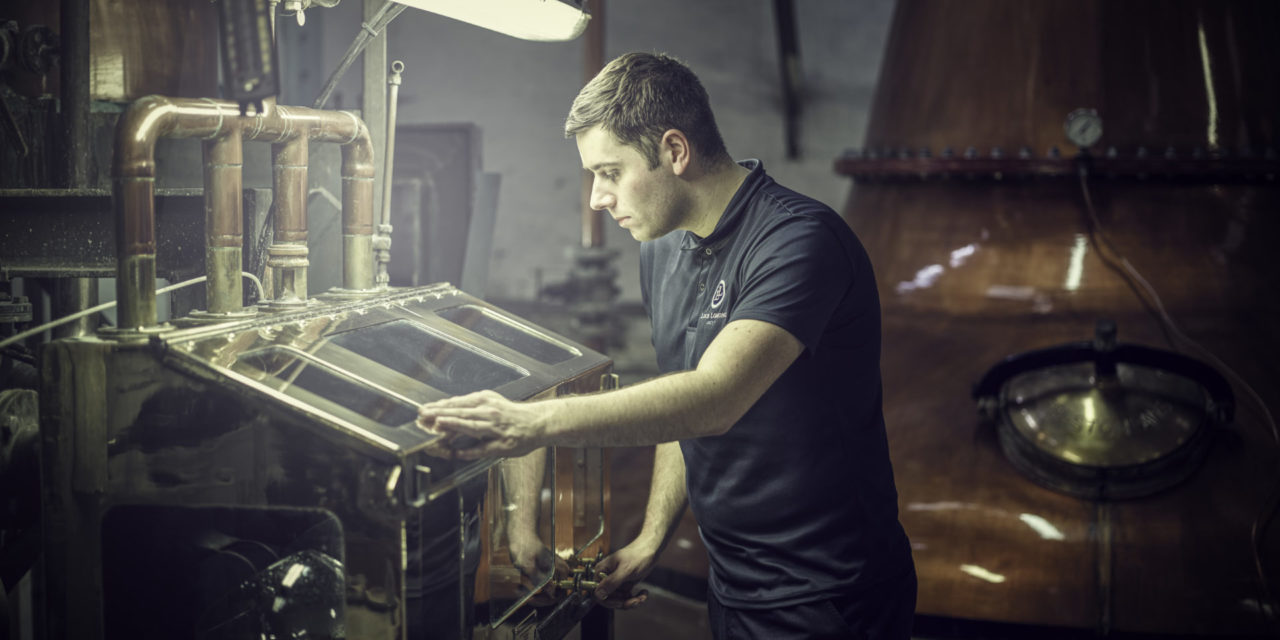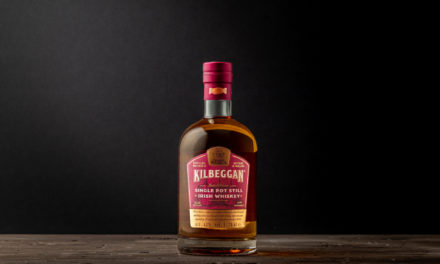At Loch Lomond Distillery in Alexandria, Scotland, distillery chemist Lorna Buchanan carefully decants seven samples of crystal-clear liquid into individual nosing glasses. They appear identical, but one sniff, and the differences are immediately revealed. The first is rich and oily, with aromas of cereal and malt. The second is pure Bartlett pear, while a third smells like citrus and spice. She holds another glass to her nose, sniffs, then passes it over. A pungent waft of peat smoke fills the air.
“These are our base spirits,” Buchanan explains. “And they show the full range of what our stills can do.”
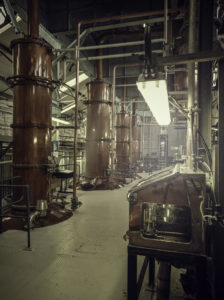
[Photo courtesy Loch Lomond]
Factor in the peated variants of its spirit and experiments with yeast, and Loch Lomond can produce a whopping 11 different types of new make whisky, each with its own unique character—and that’s before they go into barrel. That makes it an unparalleled laboratory for the impact of distillation equipment on base spirit, and the perfect place to experience the shades of gray hidden behind the traditional bifurcation of the pot still versus the column still.
The Pot Versus the Column
Many spirits consumers, familiar with the basics of distillation, have heard that pot stills produce heavy, flavorful spirits, such as Scottish single malt, while column stills make light, high-strength spirits such as vodka. One aspect of that understanding is true: The kind of still a producer uses undoubtedly impacts the flavor of their final product. If it didn’t, there’d be no reason for a distillery such as Loch Lomond to have so many different versions. But the impact of still type on spirit character isn’t as simple as many make it out be.
The first key to understand is reflux, which refers to the process of alcohol being vaporized, condensed, and re-vaporized within the main body of a still. The more reflux that happens during distillation, the higher the proof at which the spirit leaves the still, and the lighter and more refined its flavor.
The simplest batch-process stills, such as the traditional pot stills used at Loch Lomond, provide comparatively few opportunities for reflux. Alcoholic vapor in the still rises unimpeded through the open neck, traverses the lyne arm, encounters a condenser, and returns to a liquid state: spirit. That simple path means the vapor brings a plentiful supply of congeners with it (congeners are chemical traces responsible for flavor and character). By making cuts to eliminate the first and last fractions of the spirit that come over (known as “heads and tails”), distillers can fine-tune the congeners, ideally maximizing the good flavors and ethanol while minimizing the bad.
Column stills, on the other hand, accomplish reflux differently. A still can consist of one to five (or more) columns, plumbed together sequentially. Dozens of plates inside each column divide it into segments, much like the interior of a bamboo stalk. Each plate has a perforation that lets vapor pass through and condense into liquid inside the next chamber, where it later vaporizes again and passes through the next plate. Spirit exits the top of the system, while spent mash falls to the bottom. As the number of plates increases, so does the amount of reflux, which results in a higher strength spirit with fewer heavy congeners or impurities. Add enough plates, and eventually you’re making vodka, stripped clean of the flavors of the base material.
The Consequences of Congeners
This gets us to the common understanding that pot stills make rich, flavorful, lower proof spirits, while column stills produce purer, less flavorful spirits. But dig a little deeper and the picture becomes much more complicated. Sure, batch-process pot stills are used to make Cognac and single malt Scotch whisky. But bourbon, Armagnac, and Caribbean rum—all flavor-forward tipples—are often made using continuous column stills. Furthermore, hybrid systems that pair the batch process format of a pot still with one or more columns (like the Lomond still) blur the lines between the traditional dichotomy.
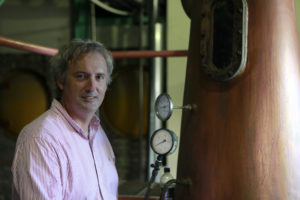
“It’s a common misconception that continuous spirits must be lighter.” —Richard Seale, Foursquare Distillery
“It’s a common misconception that continuous spirits must be lighter,” explains Richard Seale, owner and head distiller at Foursquare Distillery in Barbados. Seale uses two different still types at Foursquare: a twin column continuous Coffey still from Green Engineering, and a Caribbean double-retort batch still, manufactured by Forsyths and modified by Green Engineering. “It depends on the continuous still. A low rectification still, such as what’s used to make Agricole and American whiskey, will give you a ‘heavier’ spirit than typically produced in a batch still,” says Seale.
The converse is also true. “Batch systems are fine for vodka. Actually, on a craft scale, a batch still with a vodka column is the best way to go,” says Rob Sherman, vice president of Vendome Copper & Brass Works in Louisville, Ky.
Continuous column stills can still make flavorful products at low rectification without heads and tails extraction. This means distillers have less control over choosing which congeners to include in the final spirit. Seale points to the writings of Puerto Rican chemist and academic Rafael Arroyo, whose writings on rum are widely published: “I agree with Arroyo’s assessment that, with a continuous still, we’re either faced with making a high rectification rum, for which we lose very desirable components even if we retain some, or we make a low rectification rum, in which case, we’ll have all the good stuff but some bad stuff as well,” says Seale. “Essentially, the batch still will allow for a far superior selection by taking all of the good and rejecting as much as we can of the bad [the heads and tails]. It’s a simplified—but pretty accurate—characterization.”
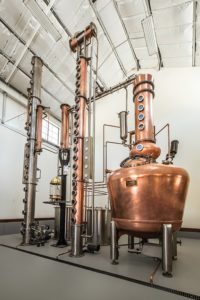
Vendome Copper & Brass Works works with clients worldwide to create a variety of still types. [Photo courtesy Vendome]
For true neutral spirit production, distillers need a lot of columns—and that can get expensive. “You can do a three-column system that will get you to 190 proof, but it may not be a clean product,” Sherman says. “Normally, you need at least a five-column system for good, clean vodka distilled in a single pass.” Fewer columns and plates means less rectification and, consequently, a higher congener level and lower ABV in the final spirit.
Loch Lomond’s two different continuous column stills are an elegant illustration of this principle. “In the grain still, we’re taking our cut at an average of 94 percent,” says Gary Mills, brand manager at Loch Lomond Group. “This gives us a wonderfully clean spirit but without too much flavor, as this is ultimately a base liquid for blending. The spirit from the Coffey still is taken at an average of 85 percent, which lets us capture more of the compounds and keep more flavor in the new make spirit.”
Bourbon, a primarily column-distilled product, has one of the highest congener levels of all spirits, as the column stills used by many producers are operated at a very low efficiency level. In fact, it’s possible that the use of heavily charred new oak casks was originally a response to the high congener level in the base spirit, as the barrel acts as a kind of charcoal filter to clean up those undesirable congeners while preserving the whiskey’s full-bodied flavor. Other ways distillers cope with the issue is by increasing copper contact by adding doublers or retorts (equipment that can add a concurrent secondary—even tertiary—distillation), or by installing components specifically designed to rectify fusel alcohols (which are prevalent in the tails).
Ultimately, though the equipment distillers use matters, it’s just one of a panoply of factors that affect how the liquor in the bottle tastes. “The still plays a role in the character of the spirit,” says Sherman, “as well as good ingredients, cooking and fermentation practices, yeast, filtration, and aging.”
Dichotomies like pot versus column might be appealingly tidy, but the truth, as in so many things, is a bit more complex.

